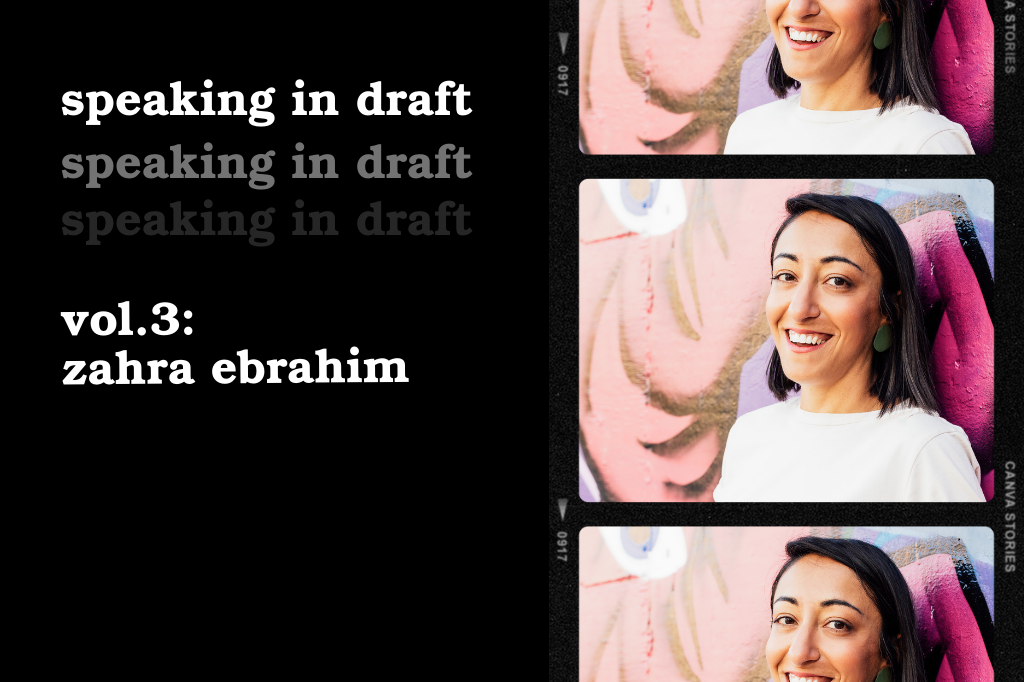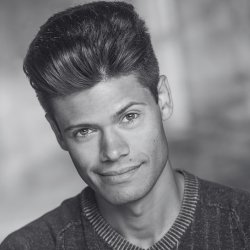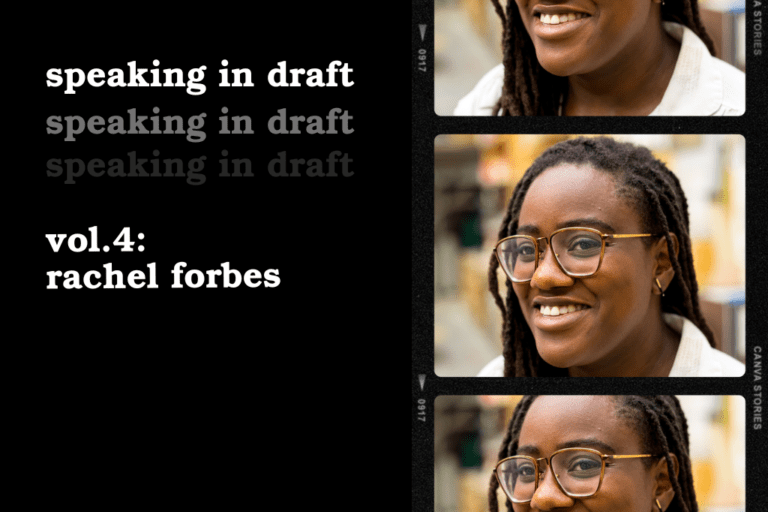Speaking in Draft: Zahra Ebrahim
Speaking in Draft is an interview series in which staff writer Nathaniel Hanula-James speaks with some of the artistic visionaries shaping Canadian theatre today. In a mixture of light-hearted banter and deep dives into artistic practice, this column invites artists to voice nascent manifestoes, ask difficult questions, and throw down the gauntlet at the feet of a glorious, frustrating art form.
What do urban design and theatre have in common?
One obvious answer is that the buildings in which we often see theatre are a product of urban design: not only in the way they look, but in how they function as public space and who they make welcome there. At the same time, could it be possible the similarities go beyond the concrete? In the world of urban design, conversations around community engagement, meaningful collaboration, and public good seem to mirror similar discourse in Canadian theatre today.
To learn more about the possible parallels between these two worlds, I met with public interest designer, strategist, and artist Zahra Ebrahim. Ebrahim is the co-founder of the equity and community-focused organization Monumental. They are also an educator, an urbanist-in-residence at the University of Toronto’s School of Cities, a Next City Vanguard Civic Leader, and a participatory artist, to name a few of their many accomplishments in a long and illustrious career. We sat down over Zoom to chat about what theatre might be able to learn from urban design.
The following interview has been lightly edited for length and clarity.
How would you describe your own work right now as a strategist and a designer and a placemaker?
There’s an alchemy to doing urbanism well. You can’t just be good at one thing. My practice has always been about a thesis, and then the skills — designer, strategist, artist, placemaker, whatever it is — feed the thesis. The thesis of my work has always been around shifting power from some to many. The medium or the spaces I work within are in hyper-local communities where folks don’t typically have access to decision making around things that determine their lived experience. That’s always been what drives my work: figuring out the role I can play — without taking up too much space — to facilitate communities taking more power and influencing decisions related to their lives.
When I say I’m a designer, people assume I’m an artifact maker, but in fact, I’m a process designer. In design, one of the things I got most enchanted by was that the process was about understanding people deeply. I am someone who researches and works with people and collaborates to really understand their lived experience, to co-create something that serves that experience.
I have used the language of artists in my practice, because I believe in emergence and I believe a good artistic process is about emergence. We need to trust in process, and talking about art in my urbanism practice allows people to understand that there will be an element of the unexpected in what we do.
We often talk a good game about process in theatre, but a lot of the time the pull toward production, and the very real constraints of funding and timelines, get in the way. How do you navigate that in your practice?
Part of how I do that is being clear about my positionality in the process. In some cases, in the projects I’ve worked on that are deeply place-based, or that are working with institutions like municipalities who are trying to connect to community, the institutions typically know what they want: they want an engagement process, or they want some feedback on a framework, like on a policy framework. It’s very unsexy stuff because they need input to get to a predetermined outcome.
My positionality in the process, if I’m a facilitator, means I have power in both communities: power defined as, people will listen to my counsel. So in those processes my goal is — this is the strategist in me — to ensure that everyone’s getting what they need: that communities are being heard and not pulled into outcomes that are not going to benefit their quality of life, and that institutions have the opportunity to understand what communities really want.
In these 20 years I’ve been an active professional, I would say that the most successful way in which I have helped to facilitate emergence — unexpected and positive impacts, redirecting resources and projects to where they actually need to go — is to help many institutions who have predetermined outcomes — [which in the context of theatre might be] ‘we want a show’ — understand that, through the process, we’re learning the outcome doesn’t need to be a show. In fact, the delivery of a show, exclusively, would actually limit the impact of your precious resources.
Institutions like the language of risk, and so I talk about de-risking by actually solving for the right problem. I’ve worked on several cases where an institution went in with a grant or a program that was meant to deliver some kind of community-based art program or some kind of output. During the process, a lot of community members were like, ‘Why are you doing this project? Why are you doing a mural? What’s your why?’ And I’m like, ‘I’m not sure.’
If you’re questioning the fundamental ‘why?,’ it’s not about saying anyone’s bad, but about saying, ‘are we solving the right problem?’
Could you give a concrete example of a project that radically shifted course because the people at stake in the project had a different idea of ‘why?’
I did research years ago with Employment and Social Development Canada around social assistance. Typically, when people aren’t accessing social services, the assumption by governments or institutions is, ‘we need more technology’ or ‘we need to put a form online.’ Whereas, when you actually spend time with seniors, you learn that a significant portion of them don’t access necessary social supports because of shame, because they don’t want their families to find out, or their friends to find out.
In another instance, a city — not because the city’s bad — wanted to do a very place-based mural project in the community, right after there had been significant gun violence in that community. People were like, ‘a mural would be nice, but we actually need a space to gather. People are scared of leaving their homes after these incidents of gun violence, and we need a communal space where people can gather, and heal, and be together again.’
In both those cases, there were problem frames that I helped take back to the institution to say, ‘I think we’re solving for the wrong problem. Can we use these resources to design something that helps people feel less shame? Or can we help design a building instead of a mural project, and we’ll work on getting the resources?’ In both cases, it led to more impactful outcomes sooner.
In the processes you’re talking about, it seems like there are institutions on one side and communities on the other. In theatre, there are the institutions and there are the community members who we call audiences — but there are also the artists in the middle.
The artists want to make work that serves the community; but I also find that artists can be suspicious of community. There can be this idea of, ‘This is my art. I’m expressing something to the world with a capital I.’ Does that tension exist in your work — between the desire for self-expression and what a community actually wants?
The other day I was having a conversation with a couple people about where ideas come from. We were debating this notion that lots of people have the same idea because they’re getting fed the same data. Maybe I have the same idea as someone in another country because we’re consuming the same media.
Then there’s another school of thought where it’s a more spiritual thing: where ideas enter the universe as an amalgam of what has existed before us, and they pass through a few bodies, and whoever has capacity to bring those to life becomes the steward of those ideas into the world.
I think it’s a little bit of both — but in both, we are stewards of preexisting notions and ideas. Always. Whether we’re making art or whether we’re building community spaces, we are facilitators of an amalgam of ideas that have existed before us: We are just sense-making in this present moment. I think to do any good social change work, you have to operate from that paradigm, whether you’re an artist or an urbanist. I think we get better creative output when we see ourselves as facilitators.
There’s a framework called Theory of Change in strategy. The really simple version is, you have a vision — here’s what the world’s going to be — and a mission — here’s my role in making that change happen. Then you map out the things you’re going to do and for whom you’re going to do them. For example, say I want people to feel more connected, and my role is to create theatre, and I create a show specifically for intergenerational audiences. That’s my goal: I want to see eight-year-olds and 80-year-olds in the audience.
That’s great, but that’s not the end of the Theory of Change. The thing I really like about the framework is it says, ‘what will they do because they saw that show?’ I love this because it forces you to say, an output has to have a ‘why?’ What do you want people to do? What does that intergenerational audience go and do because they’ve had this experience? Candidly, I think there’s some art that doesn’t do that; and that’s potentially why it doesn’t have an enduring quality.
I think there’s something that hadn’t quite clicked for me previously, but that’s clicking now with what you’ve said about Theory of Change. So often I think, in theatre, we say things like “this story needs to be told,” but we don’t think about what happens after that story is told.
Whether it be art, whether it be social change, whether it be community programs, whatever it is, I think that part is the most important part.
I want to segue into talking about space. In the last interview for this column, with We Quit Theatre, they made the point that the physical space of many Canadian theatre institutions feels unsafe for a lot of people, because they’re often classist or very white environments. Have you come across that tension in your work?
The truth is that so many of our cities in Canada were built in the modernist paradigm, and there’s a lot of research to show that modernist buildings are not safe or welcoming for communities that are multi-barriered, for communities that are diverse. Think of a lot of our major cultural institutions: theatres, galleries, museums. A lot of them are designed in this way where it’s not clear who is welcome, because they are so pristine.
Now, I think that often ends up translating to ‘community spaces need to be anti-modernist.’ I think it’s a false binary. As someone who’s studied design, I think we focus so much on the aesthetics and we don’t focus on the experiential elements of these spaces.
I did some research a few years ago that indicated that positive rules — rules that invite people to do things — really change people’s experience of public space. For instance, ‘enjoy a coffee with your friend on this bench, stay as long as you want.’ If you think about theatre or other cultural institutions, often even on the doors you see the red circle with the line through it that says ‘no pets, no strollers, no whatever.’ You’re alerted to all the things you’re potentially doing wrong before you’re celebrated for participating in culture.
Most of the conventions that we uphold are not rules. They’re not law. They are just norms created out of a system that didn’t want everyone to be there. I talk about this a lot in public consultation. When you go to a public consultation, there typically isn’t a place to hang your jacket, and there’s typically auditorium seating and a PowerPoint at the front. It’s such a convention that we open up every consultation with a presentation.
Why not ask people why they’re there? Why not flip the convention around? Knowing why everyone came, you could say, ‘hey Nathaniel, I know you came because you’re interested in green space, so I wanted to point out the green space in the project.’ It seems so simple to redesign.
I’m wondering what would happen if every time an audience member entered a lobby space, someone was there to say, ‘hey, what made you want to come to this show?’ That would be so quietly revolutionary.
Someone told me recently that [The Public Theatre] in New York is resourced enough that they have an amazing volunteer community. When you walk in, people are greeting you and connecting with you. Then, when you leave, they ask if you’ll fill out a comment card about why you came that night. When this person left the theatre, they saw people reading the comment cards. They were so touched by that.
[The ways a lot of institutions solicit feedback], in digital ways, they feel trite because they’re not a human experience. Even the way we get feedback could be so much more human. It could help people feel seen and celebrated for the difficult thing, in today’s economy, of going to see theatre. Transit’s expensive, tickets can be expensive for folks. Celebrating people is a way to get people to come back, and feel like it’s an experience that they value and want to invest in.Thank you for ending with the human connection. This has been an experiment for me because it’s not a theatre-based interview. It’s been such a delight!










Comments